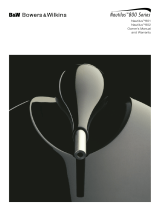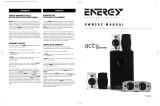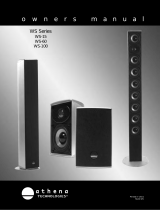
4
5.1 Surround Placement Using Two Speakers (Fig. 2c)
Place one speaker on either side of the listening area. Position so that one tweeter dome of each speaker
points toward the front of the room and the other points toward the back. Connect each speaker for Mono
sound, then use for L/R Surrounds to produce spacious 5.1 surround sound.
6.1 Rear Placement Using One Speaker (Fig. 2d)
Center one speaker behind the listening area, tweeter domes positioned toward the left and right sides of the
room. Connect speaker for Mono sound, then use as 6.1 Rear for wide-dispersion rear-channel sound.
7.1 Surround + Rear Placement Using Two
Speakers (Fig. 2e)
Place one speaker on either side of the listening area. Position so that one tweeter dome of each speaker
points toward the front of the room and use those channels for L/R surround sound. The other tweeter domes
will be pointed toward the back of the room which can then be used for L/R rear sound.
7.1 Rear Placement Using One Speaker (Fig. 2f)
Center one speaker behind the listening area with tweeter domes positioned toward the left and right sides
of the room. Connect to L/R Rears for spacious 7.1 rear-channel sound.
Placement Options for Guided Soundfiel
d
™
Models
Paradigm
®
and Paradigm
®
Reference Guided Soundfield
™
in-ceiling speakers are optimized for use in areas
with 8´ (2.4 m) to 9´ (2.74 m) high ceilings. They allow you to “guide” a wide-dispersion arc of sound toward
a specific area in much the same way we guide a floodlight to flood an area with light.
For overall clarity and balanced bass performance these speakers should be mounted in the ceiling 12” (30 cm)
or more from the wall, as shown in figs. 3a to 3f.
NOTE: Guiding the sound should be done after connecting the speaker but before
final tightening of flange
screws. See “Fine Tuning the Guided Soundfield
™
,” on page 5.
Guided Soundfield
™
Left/Right Speakers (Fig. 3a)
Follow the general guidelines for speaker placement provided at the beginning of the main section, keeping in mind
the distance from the front speakers to your primary listening area should be 10’ (3 m) to 14’ (4.3 m), as shown.
Adding a Guided Soundfield
™
Center Speaker (Fig. 3b)
Follow the directions for placement given earlier, then position the center speaker between the L/R
speakers, with drivers pointed toward the center of the listening area.
GUIDED SOUNDFIELD
™
SURROUNDS/REARS
These speakers are also ideal for use as surrounds/rears. “Guiding” the sound toward the sides and rear of the
room creates an enveloping, reverberant soundfield similar to that provided by Paradigm
®
and Paradigm
Reference ADP
™
speakers. Keep in mind that the speakers should be mounted 12” (30 cm) or more from the wall.
5.1 Surround Placement
(Fig. 3c)
Position one speaker on either side of the listening area with drivers pointed toward the side walls.
6.1 Rear Placement
(Fig. 3d)
Begin with the “5.1 Surround Placement” (above) then center one speaker behind the listening area with
drivers pointed toward the back wall.
7.1 Surround/Rear Placement
(Fig. 3e)
Begin with the “5.1 Surround Placement” (given earlier), then position another pair of speakers behind the
listening area, one slightly right, the other slightly left of the listening position, with drivers pointed to the
back of the room as shown.
Direct-Radiating Surrounds/Rears
(Fig. 3f)
Alternatively, these speakers may be used as direct-radiating speakers, positioned with drivers pointed
toward the listening area. Use fig. 3f as a guide to positioning as you experiment to achieve optimal
surround sound in your room.


















